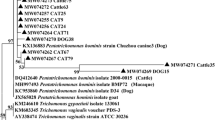Abstract
Blastocystis hominis is a common intestinal parasite observed in fecal examination. On the other hand, the transmission of this parasite is certainly unknown. The transmission of B. hominis can be realized by animal contact and the contamination by water and food with excreted cysts from the reservoir hosts. B. hominis isolated from 25 humans, their pets, and tap water was identified by polymerase chain reaction using sequenced tag site primers in this study. B. hominis isolates obtained from humans and pets were identified as subtype1, subtype2, and subtype3 while B. hominis isolates obtained from tap water were also identified as subtype1. The B. hominis isolates obtained from humans in this study were defined as the same as the subtypes of the B. hominis isolates obtained from the pets, of which these people keep at their homes, and the tap water. These findings reveal that the source of B. hominis infection could be pets and tap water.



Similar content being viewed by others
References
Abe N, Nagoshi M, Takami K, Sawano Y, Yoshikawa H (2002) A survey of Blastocystis sp. in livestock, pets, and zoo animals in Japan. Vet Parasitol 106(3):203–212
Abe N, Wu Z, Yoshikawa H (2003) Molecular characterization of Blastocytis isolates from birds by PCR with diagnostic primers and restriction fragment length polymorphism analysis of the small subunit ribosomal RNA gene. Parasitol Res 89(5):393–396
Kuo HY, Chiang DH, Wang CC, Chen TL, Fung CP, Lin CP, Cho WL, Liu CY (2008) Clinical significance of Blastocystis hominis: experience from a medical center in northern Taiwan. J Microbiol Immunol Infect 41(3):222–226
Leelayoova S, Rangsin R, Taamasri P, Naaglor T, Thathaisong U, Mungthin M (2004) Evidence of waterborne transmission of Blastocystis hominis. Am J Trop Hyg 70(6):658–662
Leelayoova S, Siripattanapipong S, Naaglor T, Taamasri P, Piyaraj P, Mungthin M (2008) Drinking water: a possible source of Blastocystis spp. subtype 1 infection in schoolchildren of a rural community in central Thailand. Am J Trop Med Hyg 79(3):401–406
Rivera WL, Tan MA (2005) Molecular characterization of Blastocystis isolates in the Philippines by ripoprinting. Parasitol Res 96(4):253–257
Noel C, Dufernez F, Gerbod D, Edgcomb VP, Delgado-Viscogliosi P, Ho LC, Singh M, Wintjens R, Sogin ML, Capron M, Pierce R, Zenner L, Viscogliosi E (2005) Molecular phylogenies of Blastocystis isolates from different hosts: implications for genetic diversity, identification of species, and zoonosis. J Clin Microbiol 43(1):348–355
Salim HR, Suresh K, Vellayan S, Mak JW, Anuar AK, Init I, Vennila GD (1999) Blastocystis in animal handlers. Parasitol Res 85(12):1032–1033
Suresh K, Salim HR, Jamaiah I, Anuar AK (2001) Blastocytis hominis in high-rise flat dwellers in Kuala Lumpur, Malaysia. Trans R Soc Trop Med Hyg 95(4):377–378
Snowden K, Logan K, Blozinski C, Hoevers J, Holman P (2000) Restriction-fragment-length polymorphism analysis of small-subunit rRNA genes of Blastocystis isolates from animal hosts. Parasitol Res 86(1):62–66
Stenzel DJ, Lee MG, Boreham PF (1997) Morphological differences in Blastocytis cysts—an indication of different species? Parasitol Res 83(5):452–457
Taamasri P, Mungthin M, Rangsin R, Tongupprakarn B, Areekul W, Leelayoova S (2000) Transmission of intestinal Blastocystis related to the quality of drinking water. Southeast Asian J Trop Med Public Health 31(1):112–117
Tan KS, Singh M, Yap EH (2002) Recent advances in Blastocystis hominis research: hot spots in terra incognita. Int J Parasitol 32(7):789–804
Tanizaki A, Yoshikawa H, Iwatani S, Kimata I (2005) Infectivity of Blastocystis isolates from chickens, quails and geese in chickens. Parasitol Res 96(1):57–61
Thathaisong U, Worapong J, Mungthin M, Tan-Ariya P, Viputtigul K, Sudatis A, Noonai A, Leelayoova S (2003) Blastocystis isolates from a pig and a horse are closely related to Blastocystis hominis. J Clin Microbiol 41(3):967–975
Wong K, Ng GC, Lin RTP, Yoshikawa H, Taylor MB, Tan KS (2008) Predominance of subtype 3 among Blastocystis isolates from a major hospital in Singapore. Parasitol Res 102(4):663–670
Yan Y, Su S, Lai R, Liao H, Ye J, Lixiabo LX, Chen G (2006) Genetic variability of Blastocystis hominis isolates in China. Parasitol Res 99(5):597–601
Yan Y, Su S, Ye J, Lai X, Lai R, Liao H, Chen G, Zhang R, Hou Z, Luo X (2007) Blastocystis sp. subtype 5: a possibly zoonotic genotype. Parasitol Res 101(6):1527–1532
Yoshikawa H, Nagano I, Yap EH, Singh M, Takahashi Y (1996) DNA polymorphism revealed by arbitrary primers polymerase chain reaction among Blastocystis strains isolated from humans, a chicken, and a reptile. J Eukaryot Microbiol 43(2):127–130
Yoshikawa H, Nagano I, Wu Z, Yap EH, Singh M, Takahashi Y (1998) Genomic polymorphism among Blastocystis hominis strains and development of subtype-specific diagnostic primers. Mol Cell Probes 12(3):153–159
Yoshikawa H, Abe N, Iwasawa M, Kitano S, Nagano I, Wu Z, Takahashi Y (2000) Genomic analysis of Blastocytis hominis strains isolated from two long-term health care facilities. J Clin Microbiol 38(4):1324–1330
Yoshikawa H, Wu Z, Nagano I, Takahashi Y (2003) Molecular comparative studies among Blastocystis isolates obtained from humans and animals. J Parasitol 89(3):585–594
Yoshikawa H, Yoshida K, Nakajima A, Yamanari K, Iwatani S, Kimata I (2004a) Fecal–oral transmission of the cyst form of Blastocystis hominis in rats. Parasitol Res 94(6):391–396
Yoshikawa H, Wu Z, Kimata I, Iseki M, Ali IK, Hossain MB, Zaman V, Haque R, Takahashi Y (2004b) Polymerase chain reaction-based genotype classification among human Blastocystis hominis populations isolated from different countries. Parasitol Res 92(1):22–29
Yoshikawa H, Abe N, Wu Z (2004c) PCR-based identification of zoonotic isolates of Blastocystis from mammals and birds. Microbiology 150(5):1147–1151
Zaki M, Zaman V, Sheikh NA (1996) Resistance of Blastocystis hominis cysts to chlorine. J Pak Med Assoc 46(8):178–179
Author information
Authors and Affiliations
Corresponding author
Rights and permissions
About this article
Cite this article
Eroglu, F., Koltas, I.S. Evaluation of the transmission mode of B. hominis by using PCR method. Parasitol Res 107, 841–845 (2010). https://doi.org/10.1007/s00436-010-1937-4
Received:
Accepted:
Published:
Issue Date:
DOI: https://doi.org/10.1007/s00436-010-1937-4




